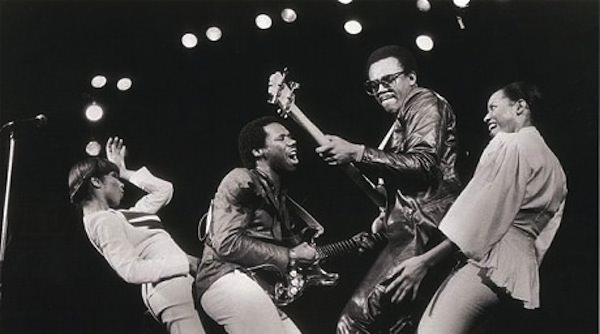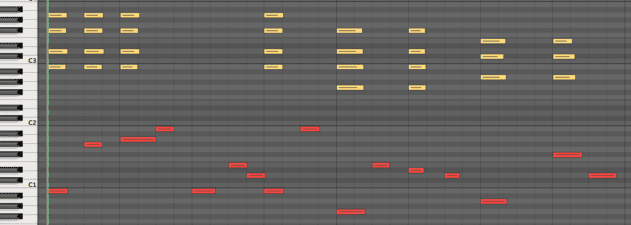Timing
The second crucial characteristic of disco chords is their timing. Syncopated rhythms and subtle interaction with other musical elements play a vital role in creating the distinctive sound of classic disco arrangements.
Syncopation describes a musical part accentuating a beat which would otherwise not be accentuated. Sticking with ‘Lost In Music’, we’ve lined up the playhead below on a snare beat in the first bar. The piano (yellow) and bass (red) play on the half beat either side of the drum hit. The same thing occurs at the same point in the third bar of the phrase.
In our reconstruction below, we can hear how this rhythmic interaction subtly accentuates both the snare and the instrument parts, creating the simple yet effective syncopated rhythm.
Audio PlayerThe way the chords, bassline and drum elements interact with each other here is the perfect reminder of a fundamental principle to bear in mind when composing music of absolutely any genre: focussing on just one instrument in isolation only tells a small part of the story. There’s no point creating a bassline which sounds incredible on its own but doesn’t work with the drum pattern or the chords. It might sound obvious, but we’re all guilty of focussing on small details at times rather than considering the more important issue of whether the piece of music works as a cohesive whole.
Theory Into Practice
Combining the principles we’ve examined here with the ideas we looked at in this earlier Passing Notes on disco house basslines, we’ve created a short example of a retro disco pattern.
Audio PlayerThe first 8 bars of the 16-bar example look like this (note that the bassline has been transposed an octave lower in this screenshot so it can be read more easily with the chords):
The chords are Bm7, Gmaj7, A.
The second 8 bars look like this:
The second half uses exactly the same chords, just voiced and positioned differently. Notice how the different inversions of the same A major triad at the end create a lift into the next section of the track.
In the second half, the bassline and chords are also shifted to land on beats not accentuated in the 4/4 drum loop.
Other genres
Of course, while techniques like this are key characteristics of genres like disco or funk, it’s important to remember how applicable they also are to other genres. Below we’ve put together a dub techno loop as a basic example.
Audio PlayerDub techno’s harmonic, melodic and rhythmic minimalism places the emphasis on sound design and subtlety of programming. Note the inversion of the E minor chord and the position of the chord stabs creating the syncopation with the four-to-the-floor drum pattern. The techniques used in disco chord progressions apply equally as well here as they do in virtually any dance genre.





12.39 AM
Very good stuff. Thanks for sharing.
04.33 AM
That was awesome, thanks heaps for putting these tips up Oliver!
04.04 PM
Just being able to visualise the slide in the piano chord is so helpful. Loving these articles.
08.29 PM
Nifty examples! I just want to point out that while inversions refer to what part of the chord is on the bottom, the specific term for voicing the melodic lines so that they aren’t disjointed is “voice leading”. You’ll find this a lot in baroque/classical music and (as Oliver points out in this article) still applies today. I also think contrary motion is really cool and adds a lot of interest. (When your bass line goes down and your melody goes up or vice versa.)
07.32 AM
Wow that was quite great.
05.15 PM
Thanks for this!im loving your articles!keep up the good work!
03.30 AM
Hey – you mean Cm7, Fm7, Abmaj7, Ebmaj7, not Cm7, Fm7, Amaj7, Ebmaj7!
05.35 PM
@Dutch: I did indeed mean Abmaj7, well spotted!
It’s been changed now, cheers!
11.23 AM
Oliver can you make a tutorial or give tips about how to make those disco strings that play at the beginning of each bar? What notes should be played? What sort of attack/release or compression creates an authentic feel? Can’t quite get them right.
06.53 PM
Thank you! I was always unsure about where to invert the chords! I always thought it was, as you put it, ” sit in a smaller frequency range”. Finally nice to hear from someone else that’s how they do it!!!!!!!
09.58 PM
Oliver these tutorials are fantastic. I would tell you to write a book, but it would be difficult to make it as interactive as your articles